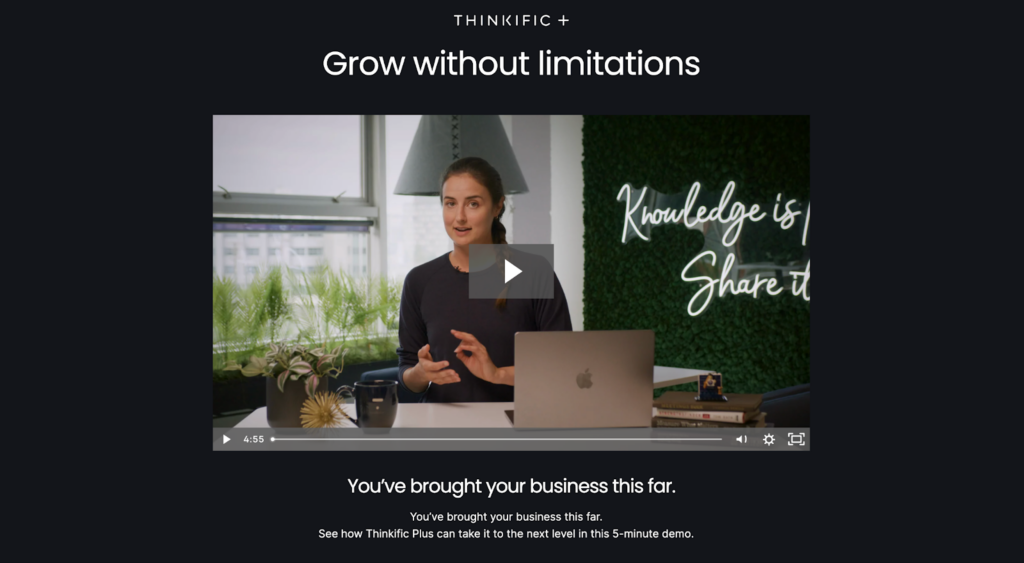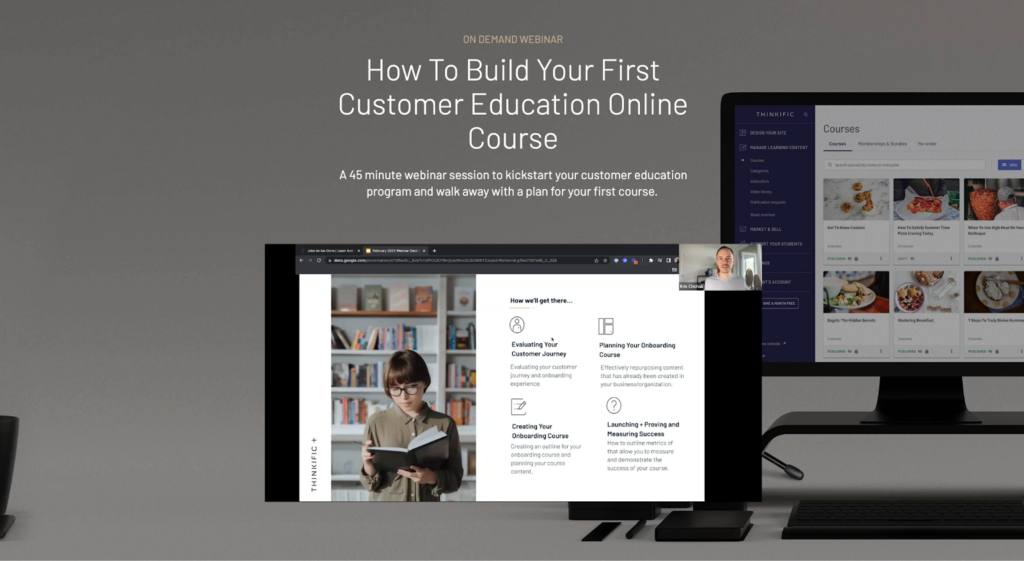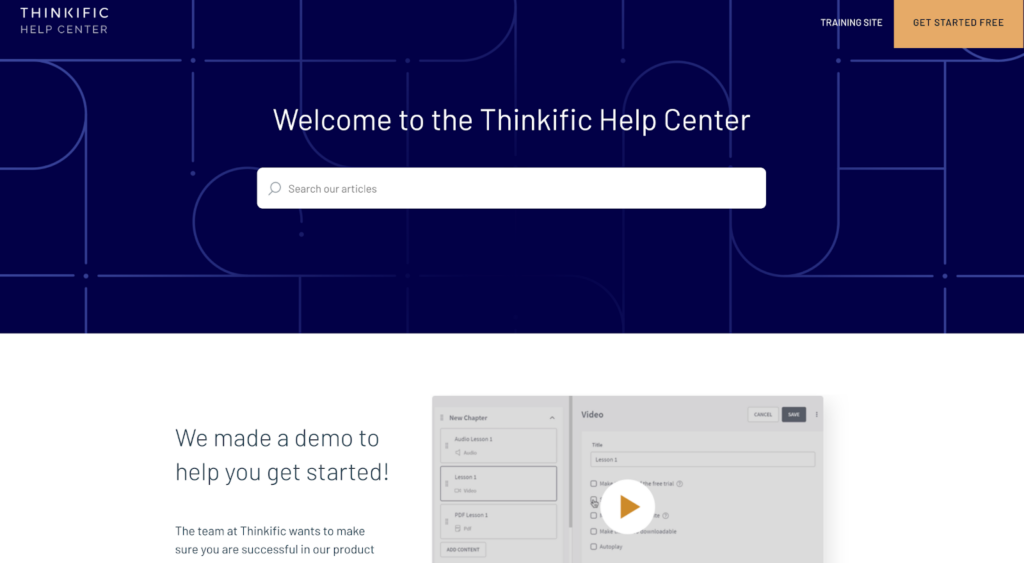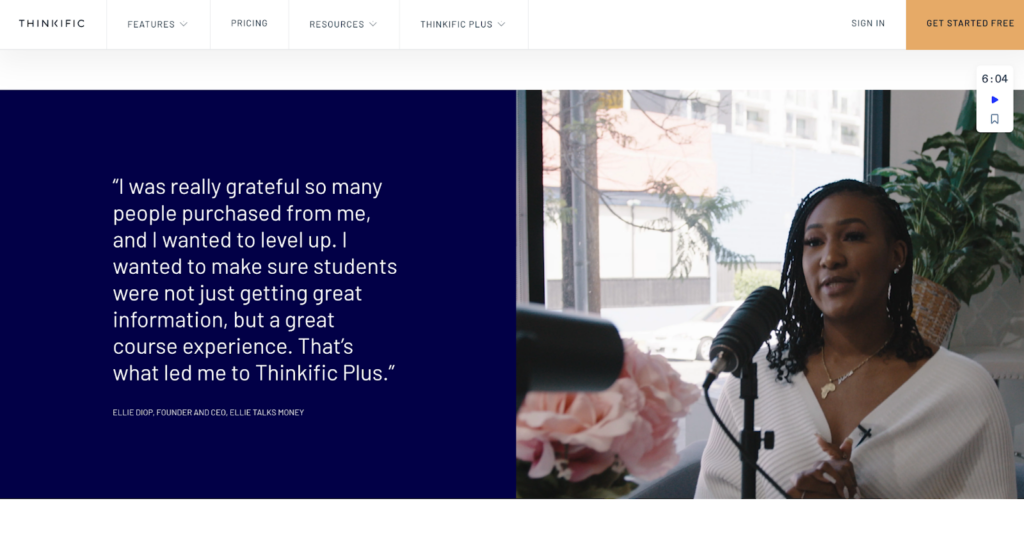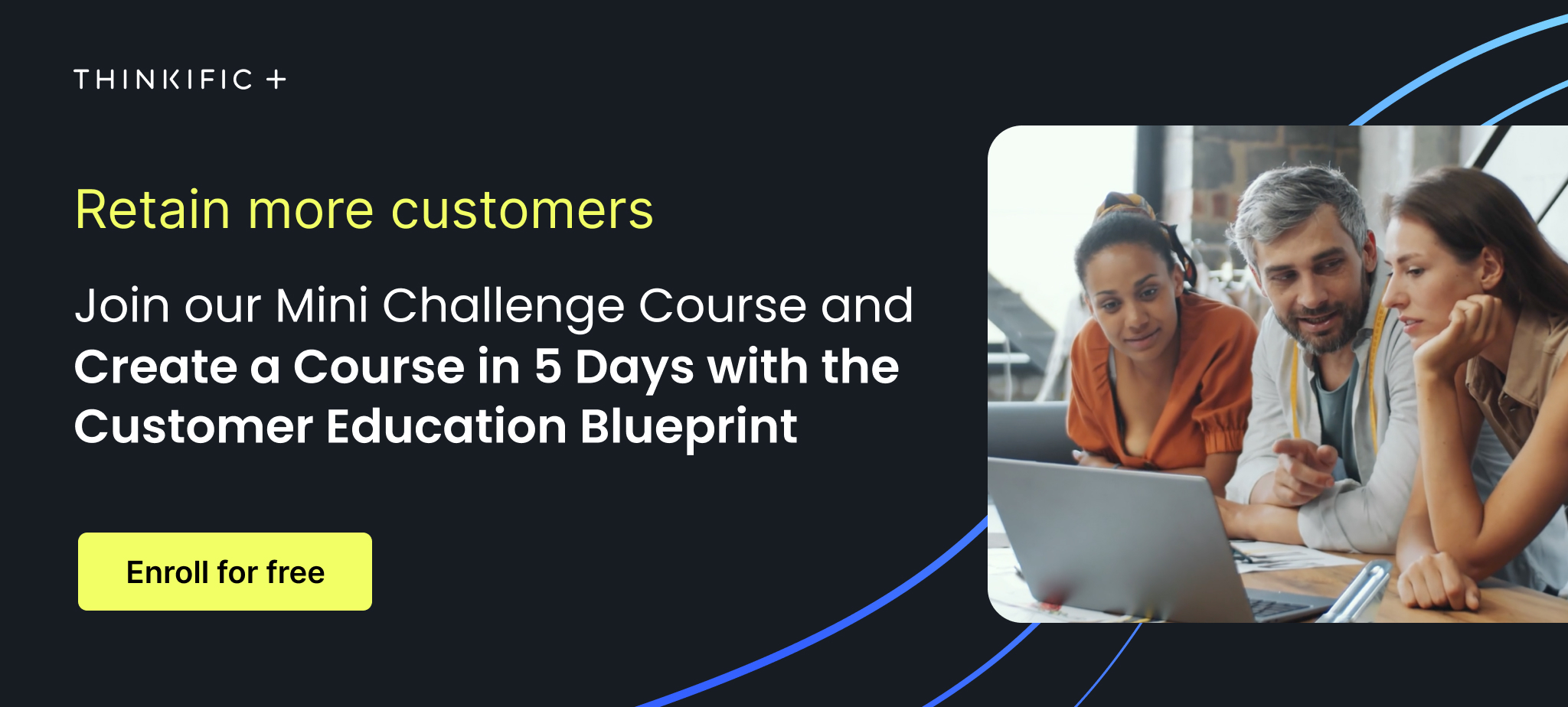A recent study conducted by Forrester Consulting found that “90% of companies have seen a positive return on their customer education investments.” Investing in customer education strategies can have a real payoff, but they must be effective to see that positive return.
As a proactive strategy, customer education is all about helping customers learn about and extract the most value from your service or product. But as the term “strategies” implies, you can go about empowering your customers and increasing adoption, engagement, trust, and loyalty in many ways.
In this article, we’ll cover five customer education examples, each a strategy of its own. You’ll learn how these strategies can help your business grow, how they help you and your customers, and how these strategies work in the real world.
Skip ahead with these links:
- Unleashing the power of customer education
- 5 Effective customer education strategies and examples
- Final thoughts
Unleashing the power of customer education
At the core of effective customer education strategies is the belief that when your customers succeed, so do you. Still, understanding the value it brings to your business is crucial, especially if you have to justify spending to stakeholders in your organization. So let’s take a look at some of the profound benefits of effective customer education.
Streamlined customer support
Fast and efficient customer onboarding accelerates your customer’s time to market and time to revenue, saving your customer a significant amount of time. But customer education isn’t merely about facilitating the customer, it’s also about optimal resource allocation.
Your in-depth product knowledge makes you the perfect educator. Building comprehensive customer education lets you address frequently asked questions and common challenges when it’s most important, cutting down on customer support inquiries and ultimately saving you time and money.
Improved adoption, retention, and expansion
Another critical metric customer education can help you improve: customer churn. A well-rounded education program can help increase adoption, retention, and expansion by helping customers understand your offering and derive maximum value from it regardless of where they are in the customer journey.
Educated customers are primed for adoption. As they master your product or service, they reach value and experience success faster, making them more likely to renew contracts and advocate for your brand.
Improved customer satisfaction and loyalty
Customers equipped with the necessary knowledge to use your product successfully are less likely to encounter problems and experience frustration as they implement your solution in their business. This not only improves their satisfaction but it makes it more likely that they’ll return because they feel supported and validated in their working relationship with you.
When customers are empowered with the knowledge to utilize your product effectively, they face fewer issues and are less frustrated. This not only enhances their satisfaction but also fosters loyalty, as they value your support and feel validated in their decision to work with you.
Enhanced brand reputation and trust
Brand reputation and trust are pivotal to business success, and an effective customer education strategy significantly contributes to both.
By providing valuable, clear, and easily accessible information about your product or service, you enhance your brand’s reputation. Your efforts also display in-depth product knowledge and a commitment to customer success. This transparency fosters customer trust and shows that your company isn’t just selling a product but genuinely understands its value and potential.
Related: The Ultimate Guide to Customer Success
5 Effective customer education strategies and examples
With the benefits of an effective customer education strategy behind us, it’s time to examine how you can make those benefits a reality.
The best customer education strategy perfectly aligns with your customers’ needs and learning styles. Here, we’ll explore five highly effective customer education strategies and provide real-world customer education examples. These examples illustrate the practical application of each strategy and how they contribute to customer success.
Video and multimedia resources
In a 2023 report, Wyzowl found that “96% of people have watched an explainer video to learn more about a product or service.” And a shocking 89% of people reported that watching an explainer video led to purchasing a product or service. These figures make it clear that video and multimedia resources aren’t just excellent for educating customers at all steps in the customer journey, they’re necessary.
Videos are much more engaging than reading a manual online, and they’re incredibly effective when trying to educate your audience on highly technical offerings. By leveraging engaging product demos, walk-throughs, and explainer videos, you can deliver tangible insights into your product or service, facilitating an immersive, engaging, and valuable learning experience.
For example, cybersecurity companies often deploy animated videos to demonstrate how their services or products solve a security problem, whether it’s through a software download or a training program. This provides clear, visual education for viewers.
Product demos are another excellent example of using video in customer education. Video content can live on almost any platform. Take a look at how we offer video content in customer education with this Thinkific Plus platform demo. In it, we walk viewers through the easy process of creating a course, adding enrollment and checkout features, integrations, and more. Or check out our library of content that lives on YouTube, helping users navigate the Thinkific platform.
Webinars and live training sessions
Webinars and live training sessions are potent tools in an effective customer education strategy. These methods allow customers to connect directly with experts from your organization, allowing for immediate feedback with pinpoint accuracy and a strengthened sense of support.
Webinars are an excellent platform for in-depth exploration of your offerings. They work great when you dive into functionality, features, and best use cases. Meanwhile, live training sessions can be tailored to a specific group and their needs. Are there common issues your support team encounters? A live training session may be the perfect solution to ensure potential and current customers are equipped to maximize the value they receive from your product or service.
For example, our very own Lifecycle Marketing Manager Kris Chichack hosted a webinar titled “How To Build Your First Customer Education Online Course.” In this webinar, Kris teaches people how to kickstart their customer education with an onboarding course, provides a 5 step framework to do that, and helps viewers understand how to launch, prove, and measure the success of their course. Throughout the webinar, he’s able to directly engage with Thinkific Plus customers, answering live questions and using their feedback as real-time examples within the webinar.
Knowledge base and self-service portals
A knowledge base is a self-serve library where customers can go to access information that helps them answer a question or resolve a problem they’re experiencing with your service or product.
Today, people expect easy and immediate access to information. Self-service portals offer exactly that while simultaneously empowering customers to solve issues independently. This builds your customer’s trust and confidence in the product and alleviates customer support inquiries, saving your support staff time and you money.
Companies like Google and Microsoft have harnessed the power of knowledge bases and self-service portals. And in addition to our Facebook community and FAQ section, we’ve also created a comprehensive resource library. There, users can find support on broad topics, like where and how to start their online course on our platform, or find assistance with specific tasks like installing Google Analytics 4.
Please note that while self-service help centers have become an expectation in today’s world, this strategy alone is not enough to satisfy or educate customers. Self-service help centers and resource libraries work best when supplementing the other strategies we’ve featured such as online courses and education.
Case studies and success stories
Case studies and success stories form a crucial part of any education strategy. These give potential customers proof of your product’s potential and its impact on real-world businesses. Case studies work hard to humanize your offering, present relatable narratives, and inspire and educate your customers, both potential and current.
Here’s Ellie Talks Money’s Case Study, for example. Ellie Diop is the founder of Online Academy “Ellie Talks Money” where she helps businesses scale through digital marketing strategies using Thinkific Plus. In it, readers will learn about Ellie’s journey growing her business with online learning products, and what led her to reach 7 figures in revenue using the platform.
Case studies and success stories can be distributed in various ways too. For example, we combined a video with a success story to share how Hootsuite grew brand advocacy with customer education courses. The best approach to customer education using this method includes a variety of channels, helping you reach customers across multiple platforms.
Online courses, academies and learning programs
Online courses have become a cornerstone of effective customer education. Courses allow you to offer structured, interactive learning experiences that cater to customers’ busy schedules and learning preferences.
The appeal of online courses lies in their inherent flexibility and personalization. In addition to self-paced learning, online courses let your customers dive deep into the workings of your product or service in a way that’s formulated specifically for them by your organization’s experts. Using gamification or engagement tools like multimedia content, quizzes, and real-world examples further bolsters your course’s efficacy.
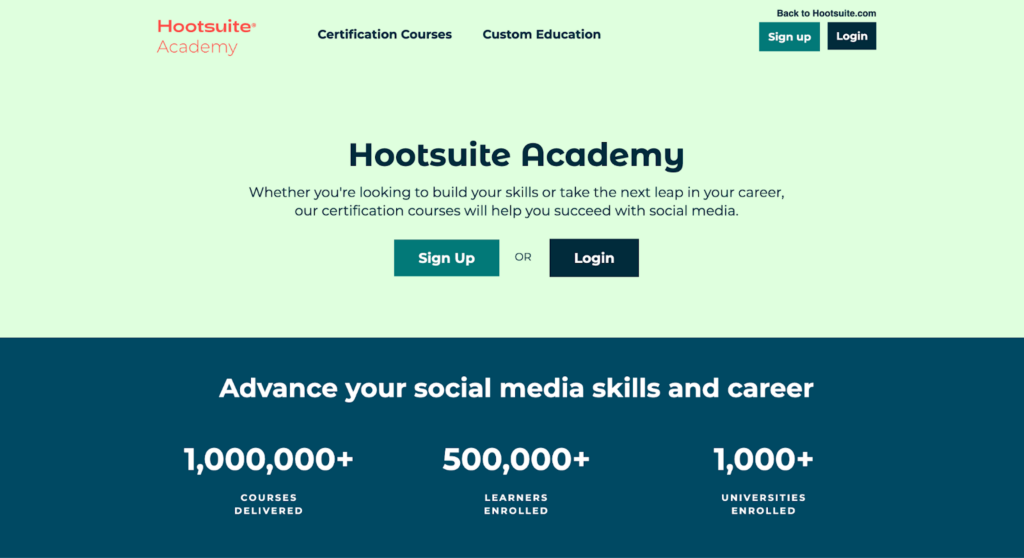 Thinkific Plus Customer Hootsuite’s “Hootsuite Academy”
Thinkific Plus Customer Hootsuite’s “Hootsuite Academy”
Creating effective online courses
Developing an impactful and valuable course goes beyond content creation. To craft a course that increases adoption and fosters trust with your customers, you’ll have to isolate your learning objectives. In other words, what are the fundamental concepts your customers must learn within the course?
In addition to defining clear learning objectives, there are some key elements that support the performance of your online course. We’ve identified four such elements. While some of these elements enhance your overall customer education strategy, others cater specifically to enriching your online course experience.
- Supporting resources like FAQs and a resource library supplement online course material. These are excellent for topics that don’t warrant an entire module or lesson, but are still essential— like installing Google Analytics 4, an example from earlier.
- An active community allows your customers to observe and learn from others as they implement your offering in their own businesses. Communities are also alternative solutions for problem-solving, which can help you reduce your customer support inquiries.
- Tracking customer progress and recognizing their achievements serves a dual purpose—it keeps customers motivated, urging them to complete your onboarding course, and provides crucial insights into the effectiveness of your course, allowing you to adjust your course for optimal adoption, retention, and expansion.
- Case studies, or success stories, allow you to reinforce the proven success of your offering within your course content. When success stories are broken down in detail, they can also give your customers a step-by-step look at how real-world companies have implemented your product or service.
- Built-in feedback mechanisms are crucial when it comes to continuous improvement. Regular questionnaires, surveys, and comment sections can help you gauge what’s working and what isn’t directly from your customers. This feedback is valuable as you make changes to your program over time, giving customers a sense of involvement in your education process.
Assess the effectiveness of your online course periodically. Adjust and refine the course content based on feedback you receive, customer engagement metrics, and changes to your offering. This will help you maintain relevance and efficacy as you educate your customers. The goal is to empower your customers, foster trust, and enhance their overall experience with your offering and your business.
Free Mini Course: All you need to know to build your first Customer Education online course in 45 minutes.
Final thoughts
The potential for customer education to enhance user knowledge and engagement is immense. In this article, we explored a variety of examples of customer education to achieve this, including video and multimedia resources, webinars, self-service portals, case studies, and online courses.
Remember, effective customer education strategies aren’t static. They need your consistent monitoring, which includes measuring and analyzing metrics, engagement data, and feedback. Ongoing optimization based on these insights will help you maintain or improve the efficacy of your customer education.
Take these examples of customer education to heart, incorporate them into your initiatives, and see the positive impact on customer satisfaction, loyalty, and success.
Unlock the power of customer education.
With The Customer Education Blueprint, you’ll gain a comprehensive understanding of how to create a customer education academy that empowers your customers, ensures their success, and drives brand loyalty.

